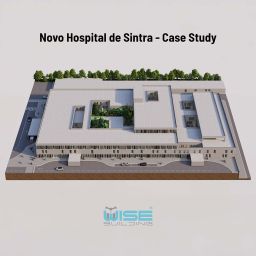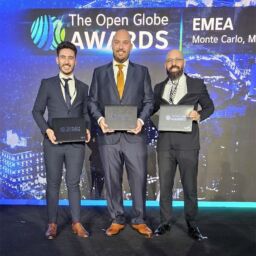A house on fire
In a forgotten corner of a pulsating city, a building rises, a silent witness to the relentless advance of time. This building, once an icon of modernity, is now facing one of the greatest challenges of the contemporary era: climate change. It’s not a battle visible to the naked eye, but a war fought in the bowels of its infrastructure, where BMS become the silent heroes of this new era. Adapting these systems is not just a choice, but an urgent necessity to guarantee the sustainability, efficiency and resilience of our living and working spaces. Global warming is a reality that has been proven over and over again for decades. Adaptation is needed!

Challenges posed by climate change
As the planet faces an increase in extreme weather events, with the frequency of heatwaves increasing by more than 30% in global urban regions over the last decade, according to the World Meteorological Organisation (WMO), the operability and efficiency of Centralised Technical Management (CTM) systems are severely tested. Such extreme weather events, together with changes in climate patterns, such as the rise in global average temperatures predicted to exceed 1.5°C above pre-industrial levels by 2040, according to reports by the Intergovernmental Panel on Climate Change (IPCC), impose significant challenges on traditional TCM systems. These extreme conditions lead to a high and often unpredictable demand for air conditioning, pushing GTC systems to operate beyond their designed capacities, resulting in reduced efficiency and substantial increases in energy consumption. Meeting these challenges requires the implementation of new adaptation strategies, including the recalibration of GTC systems to ensure resilience, the integration of accurate weather forecasts into operational planning, and the adoption of advanced energy efficiency technologies. Without effective adaptation, the gap between the capacity of GTC systems and the demands imposed by a changing climate will continue to grow, exacerbating the environmental impact of buildings and jeopardising the long-term sustainability of our urban infrastructures.
Faced with the growing challenges posed by climate change, adaptation strategies and innovation in GTC systems are becoming crucial to ensure the resilience and efficiency of buildings. One innovative approach that is gaining prominence is the integration of nature-based solutions (NBS), which according to the International Union for Conservation of Nature (IUCN), can reduce the temperature of buildings by up to 8°C, contributing significantly to reducing the load on air conditioning systems. At the same time, the implementation of intelligent energy management systems, which can reduce energy consumption in commercial buildings by up to 30 per cent, according to the International Energy Agency (IEA), represents another vital strategy. These systems use real-time data to optimise energy performance, adapting automatically to changes in climatic conditions and building use patterns.
At WiseBuilding we endeavour to be at the forefront of implementing these innovations, offering TCM solutions that not only respond to today’s climate challenges, but also pave the way for a more sustainable future.
Case Studies and Empirical Evidence

The commitment to sustainability and adaptation to climate change has never been more evident than in the implementation of innovative TCM projects aimed at increasing energy efficiency and reducing the environmental impact of buildings. An emblematic example of this approach was the project carried out by WiseBuilding at the TERM Research Hub, which has since been published and is dedicated to tissue engineering and regenerative medicine.
This project, carried out in 2021, stands out for its integration of advanced GTC solutions aimed at optimising energy consumption and guaranteeing an ideal internal environment for the sensitive research carried out at the hub. The focus was on implementing systems that respond dynamically to external climatic variations, maintaining stable internal conditions favourable to research and development.
By installing intelligent energy monitoring and management systems, the TERM Research Hub has achieved significant reductions in its energy consumption, demonstrating the potential of these technologies to promote greener buildings adapted to today’s climate requirements.
Can we help?
We would like to take this opportunity to remind you of Decree-Law 101-D/2020, which states that until 31 December 2025 The installation of automation and control systems is now mandatory for all commercial and service buildings with heating systems or cooling systems or combined heating and ventilation systems or combined cooling and ventilation systems with an overall rated power equal to or greater than 290 kW. Sounds like a long time, but it’s not!
And adapting GTC systems to climate change is not just a preventative measure; it is an essential strategy for ensuring the future viability of our built spaces. By adopting innovative and sustainable approaches, we are not only protecting our heritage but also contributing to a world that is more resilient and adapted to the realities of tomorrow. As partners, we want building managers and owners to have the tools and knowledge they need to navigate these turbulent waters. But the question remains: are we ready to transform our buildings, not just to survive, but to thrive in this new climate?
Useful references
Agência Internacional de Energia (AIE) – Relatório sobre a eficiência energética em edifícios comerciais e industriais (2023):
Energy Efficiency 2023 – Analysis – IEAPainel Intergovernamental sobre Mudanças Climáticas (IPCC) – Impacto das mudanças climáticas na gestão e operação de edifícios (2022):
Climate Change 2022: Impacts, Adaptation and Vulnerability – IPCCInsights e recursos relevantes sobre adaptação e sustentabilidade em edifício:
Global Center on Adaptation
A WiseBuilding® está capacitada tecnicamente para apoiar em qualquer projecto que inclua a integração de sistemas GTC/SACE e conta, desde sempre, com o interesse na mitigação dos efeitos das alterações climáticas. Consulte-nos.
WISEFRAMEWORK is a BACnet B-AWS certified software solution for state-of-the-art integration, control, management and visualisation in building automation systems. Designed to redefine the way buildings are operated through an open platform and seamless harmonisation between building-generated data by supporting multiple protocols including BACnet, Modbus, KNX, OPC-UA and MQTT. Through the use of Haystack technology, the software also empowers the building for the future at the forefront in the integration of the various technical systems.










